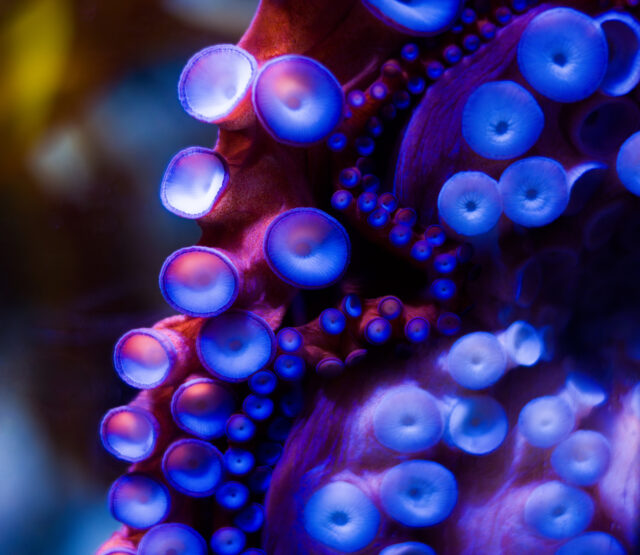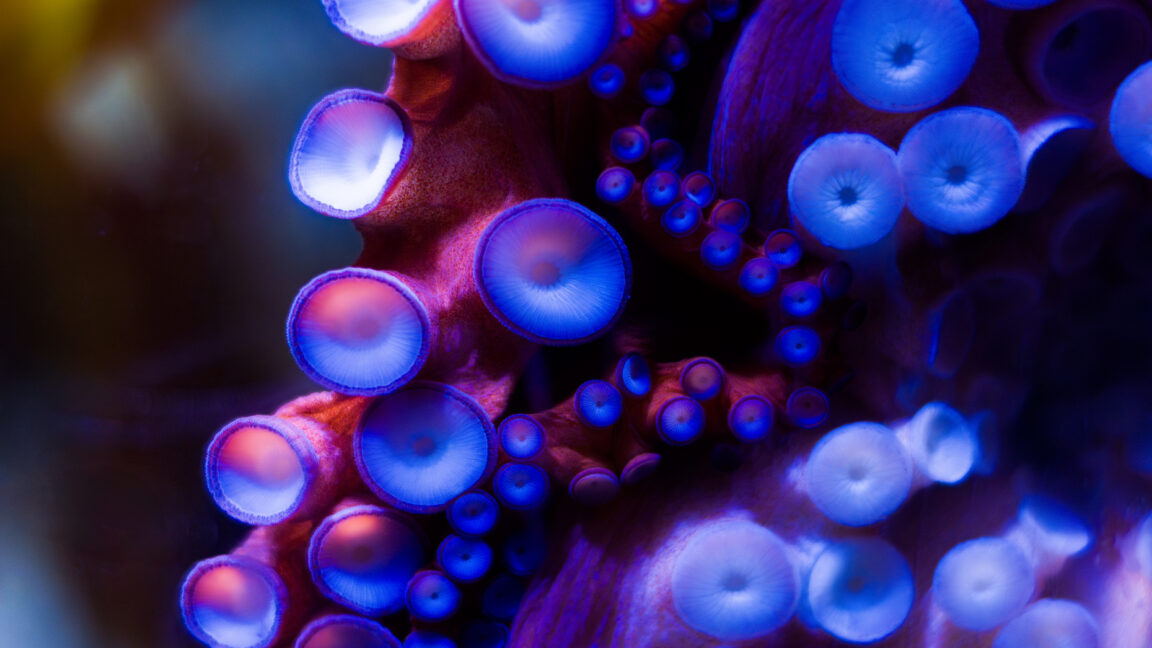- Регистрация
- 17 Февраль 2018
- Сообщения
- 38 866
- Лучшие ответы
- 0
- Reactions
- 0
- Баллы
- 2 093
Offline
Gripping and releasing irregular surfaces is harder than it might seem.


Credit: Adventure_Photo
Some of the most ingenious tech has been inspired by nature. From color-changing materials that function like cephalopod skin to a tiny biomimetic robot that looks and moves like an actual cockroach, the extraordinary adaptations of some organisms have upgraded our technological capabilities. Now the octopus is lending an arm—or a sucker.
Octopus tentacles have remarkably strong suckers with an adhesion power that could be an asset to soft robots that need to pick things up and hold onto them. Existing artificial suction cups have trouble with irregular surfaces such as rocks and shells. Cephalopods such as octopuses and squid have evolved biological suckers that can adapt to each surface and attach to them. This is why a team of researchers at the University of Bristol, led by Tianqi Yue, have created robotic suckers that are closer to the real thing than ever.
One reason biological suckers have an edge is mucus secretion, better enabling them to stick on an irregular surface. While robotic suckers can’t exactly go there, Yue figured out a way for them to use water instead of mucus.
“Organisms dexterously deform their soft body to make a rough shape conformation on the substrate,” Yue and his team said in a study recently published in PNAS. “They then use their in-sucker mechanoreceptors to perceive the suction leakage and secrete an appropriate amount of mucus to form an effective mucus seal.”
So, you want to be an octopus?
Suckers on the arms of an octopus grip things when their mechanoreceptor cells, which detect stimuli such as the texture of a surface, send a message to its brain that tells the animal how the sucker should deform to adhere to that surface with as little leakage as possible. Mechanoreceptors also tell the suckers how much mucus to produce for optimal grip. Muscles contract to reduce water pressure inside the sucker. An octopus can detach from an object by having its muscles release tension.
This isn’t the first time suction cups were inspired by highly adaptive octopus suckers. Some models have used pressurized chambers meant to push against a surface and conform to it. Others have focused more on matching the morphology of a biological sucker. This has included giving the suckers microdenticles, the tiny tooth-like projections on octopus suckers that give them a stronger grip.
Previous methods of artificial conformation have had some success, but they could be prone to leakage from gaps between the sucker and the surface it is trying to stick to, and they often needed vacuum pumps to operate. Yue and his team created a sucker that was morphologically and mechanically similar to that of an octopus.
Suckers are muscular structures with an extreme flexibility that helps them conform to objects without leakage, contract when gripping objects, and release tension when letting them go. This inspired the researchers to create suckers from a silicone sponge material on the inside and a soft silicone pad on the outside.
For the ultimate biomimicry, Yue thought that the answer to the problems experienced with previous models was to come up with a sucker that simulated the mucus secretion of octopus suckers.
This really sucks
Cephalopod suction was previously thought to be a product of these creatures’ soft, flexible bodies, which can deform easily to adapt to whatever surface it needs to grip. Mucus secretion was mostly overlooked until Yue decided to incorporate it into his robo-suckers.
Mollusk mucus is known to be five times more viscous than water. For Yue’s suckers, an artificial fluidic system, designed to mimic the secretions released by glands on a biological sucker, creates a liquid seal between the sucker and the surface it is adhering to, just about eliminating gaps. It might not have the strength of octopus slime, but water is the next best option for a robot that is going to be immersed in water when it goes exploring, possibly in underwater caves or at the bottom of the ocean.
Even without actual mucus, suction cups with a water seal have been found to hang onto things 55 times longer than those without.
There is the issue of gaps between the sucker and the surface it sticks to. The larger the gaps, the faster the sucker will lose its grip. The artificial suckers first try to conform to a surface mechanically as much as possible. While this should make any gaps small, those gaps are then sealed by the artificial fluidic system. A syringe would pump air through a tube connected directly to the suction cup so it could be reset for every trial.
When faced with challenging surfaces, such as rocks and plastic figures with rough textures and many curves, the silicone sucker on its robotic arm was able to conform to them and hold its grip for long periods of time with barely any leakage.
“[Our] suction mechanism demonstrates the great potential of liquid regulation in improving suction adaptation and shows strong adaptive suction on challenging complex dry surfaces,” the researchers said. “It enables a unique, low-cost, clean and powerful soft adhesion strategy for next-generation robots.”
Now that technology has created such eerily realistic suckers, watch out for entire tentacles full of them.
PNAS 2025. DOI: 10.1073/pnas.2314359121


Credit: Adventure_Photo
Some of the most ingenious tech has been inspired by nature. From color-changing materials that function like cephalopod skin to a tiny biomimetic robot that looks and moves like an actual cockroach, the extraordinary adaptations of some organisms have upgraded our technological capabilities. Now the octopus is lending an arm—or a sucker.
Octopus tentacles have remarkably strong suckers with an adhesion power that could be an asset to soft robots that need to pick things up and hold onto them. Existing artificial suction cups have trouble with irregular surfaces such as rocks and shells. Cephalopods such as octopuses and squid have evolved biological suckers that can adapt to each surface and attach to them. This is why a team of researchers at the University of Bristol, led by Tianqi Yue, have created robotic suckers that are closer to the real thing than ever.
One reason biological suckers have an edge is mucus secretion, better enabling them to stick on an irregular surface. While robotic suckers can’t exactly go there, Yue figured out a way for them to use water instead of mucus.
“Organisms dexterously deform their soft body to make a rough shape conformation on the substrate,” Yue and his team said in a study recently published in PNAS. “They then use their in-sucker mechanoreceptors to perceive the suction leakage and secrete an appropriate amount of mucus to form an effective mucus seal.”
So, you want to be an octopus?
Suckers on the arms of an octopus grip things when their mechanoreceptor cells, which detect stimuli such as the texture of a surface, send a message to its brain that tells the animal how the sucker should deform to adhere to that surface with as little leakage as possible. Mechanoreceptors also tell the suckers how much mucus to produce for optimal grip. Muscles contract to reduce water pressure inside the sucker. An octopus can detach from an object by having its muscles release tension.
This isn’t the first time suction cups were inspired by highly adaptive octopus suckers. Some models have used pressurized chambers meant to push against a surface and conform to it. Others have focused more on matching the morphology of a biological sucker. This has included giving the suckers microdenticles, the tiny tooth-like projections on octopus suckers that give them a stronger grip.
Previous methods of artificial conformation have had some success, but they could be prone to leakage from gaps between the sucker and the surface it is trying to stick to, and they often needed vacuum pumps to operate. Yue and his team created a sucker that was morphologically and mechanically similar to that of an octopus.
Suckers are muscular structures with an extreme flexibility that helps them conform to objects without leakage, contract when gripping objects, and release tension when letting them go. This inspired the researchers to create suckers from a silicone sponge material on the inside and a soft silicone pad on the outside.
For the ultimate biomimicry, Yue thought that the answer to the problems experienced with previous models was to come up with a sucker that simulated the mucus secretion of octopus suckers.
This really sucks
Cephalopod suction was previously thought to be a product of these creatures’ soft, flexible bodies, which can deform easily to adapt to whatever surface it needs to grip. Mucus secretion was mostly overlooked until Yue decided to incorporate it into his robo-suckers.
Mollusk mucus is known to be five times more viscous than water. For Yue’s suckers, an artificial fluidic system, designed to mimic the secretions released by glands on a biological sucker, creates a liquid seal between the sucker and the surface it is adhering to, just about eliminating gaps. It might not have the strength of octopus slime, but water is the next best option for a robot that is going to be immersed in water when it goes exploring, possibly in underwater caves or at the bottom of the ocean.
Even without actual mucus, suction cups with a water seal have been found to hang onto things 55 times longer than those without.
There is the issue of gaps between the sucker and the surface it sticks to. The larger the gaps, the faster the sucker will lose its grip. The artificial suckers first try to conform to a surface mechanically as much as possible. While this should make any gaps small, those gaps are then sealed by the artificial fluidic system. A syringe would pump air through a tube connected directly to the suction cup so it could be reset for every trial.
When faced with challenging surfaces, such as rocks and plastic figures with rough textures and many curves, the silicone sucker on its robotic arm was able to conform to them and hold its grip for long periods of time with barely any leakage.
“[Our] suction mechanism demonstrates the great potential of liquid regulation in improving suction adaptation and shows strong adaptive suction on challenging complex dry surfaces,” the researchers said. “It enables a unique, low-cost, clean and powerful soft adhesion strategy for next-generation robots.”
Now that technology has created such eerily realistic suckers, watch out for entire tentacles full of them.
PNAS 2025. DOI: 10.1073/pnas.2314359121
